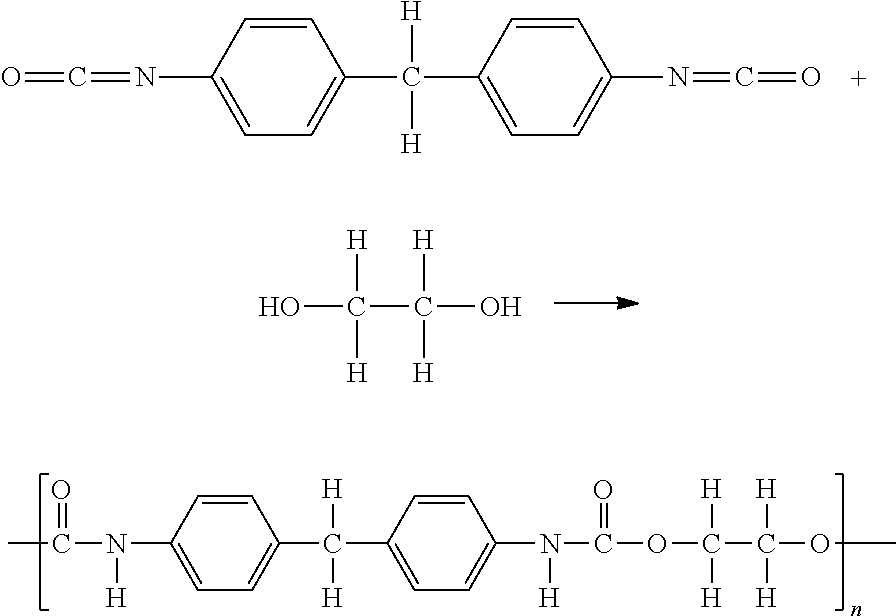Process for the preparation of lignin based polyurethane products
- Summary
- Abstract
- Description
- Claims
- Application Information
AI Technical Summary
Benefits of technology
Problems solved by technology
Method used
Image
Examples
example 1
[0169]Rigid polyisocyanurate foam laminate boards (PIR) were manufactured by a continuous lamination process, using the formulations shown in Table 1. “A side” comprises the lignin-isocyanate mixture and “B side” comprises the polyol containing resin. One sample was prepared using dried lignin and another sample was prepared using undried lignin for comparison. The dried lignin was obtained using a flash dryer with air temperature at about 230° C. The water content of the dried lignin was approximately 0.5% by weight. The water content of the undried lignin was approximately 5.5% by weight.
[0170]Laminate board samples were made on a Kornelac™ laminator. The laminator is 7.0 meters long and can produce boards up to 1.25 meters wide and 11.4 centimeters thick. The conveyor can be heated to 82° C., and the laydown table to 54° C. The laminator conditions are shown in the Table 1.
[0171]PIR panels were made to a thickness of 7.6 cm and 122 cm wide, as described in Table 1.
TABLE 1Preparat...
example 2
[0173]Structural insulated panels (SIPs) were manufactured by a discontinuous process and using the formulation shown in Table 2. “A side” comprises the lignin-isocyanate mixture and “B side” comprises the polyol containing resin. The water content of the dried lignin used in the lignin-isocyanate mixture was approximately 0.5% by weight. A 122 cm width×244 cm length plywood board was positioned in a mold and a second plywood board with the same dimensions was placed on top of it, at a predetermined distance above the first sheet. The lignin-isocyanate blend and the resin were mixed together and immediately injected inside the mold, between the two plywood boards. During the process of the SIPs foam forming, a continuous pressure sufficient to maintain the mold closed was applied to obtain the desired panel thickness. The dimensions of the obtained foam between the two plywood boards were 9.2 cm thickness×114 cm width×236 cm length.
TABLE 2Preparation of SIP panels and propertiesSamp...
example 3
[0174]Spray polyurethane foam (SPF) was prepared using the formulation shown in Table 3. Mixtures of resin and iso-lignin (lignin water content of approximately 1%) were prepared and introduced using transfer pumps to two separate tanks (tank A: mixture of iso-lignin; tank B: resin) connected to a high pressure proportioner spray machine model H-2000 from GUSMER Corporation, pre-set to a ratio of 1:1 by volume (could also be set to a ratio of 2:1). The work pressure can be adjusted as needed (between 6.2 and 8.3 MPa up to 13.8 MPa) and the temperature of the mixture can vary between 50 and 60° C. The foam was then sprayed with a gun on a rigid and dry substrate.
TABLE 3Preparation of SPF and propertiesSamples, % of total foamA sidePAPI 2739.97Sodium Lignosulfonate9.99B sideStepanpol ® PS 235216.45IXOL B-2517.71SPA-5303.93TEAP-2651.34EDAP-8002.69TCPP4.82Silstab ® 21000.64Polycat ® 50.96Polycat ® 90.77Dabco ® BDMA0.77T-120.77Water0.46HFC-365mfc / 227ea 87-13%7.71HFC-245fa0.96I BLU 3320.0...
PUM
| Property | Measurement | Unit |
|---|---|---|
| Temperature | aaaaa | aaaaa |
| Temperature | aaaaa | aaaaa |
| Temperature | aaaaa | aaaaa |
Abstract
Description
Claims
Application Information
 Login to View More
Login to View More - R&D
- Intellectual Property
- Life Sciences
- Materials
- Tech Scout
- Unparalleled Data Quality
- Higher Quality Content
- 60% Fewer Hallucinations
Browse by: Latest US Patents, China's latest patents, Technical Efficacy Thesaurus, Application Domain, Technology Topic, Popular Technical Reports.
© 2025 PatSnap. All rights reserved.Legal|Privacy policy|Modern Slavery Act Transparency Statement|Sitemap|About US| Contact US: help@patsnap.com


